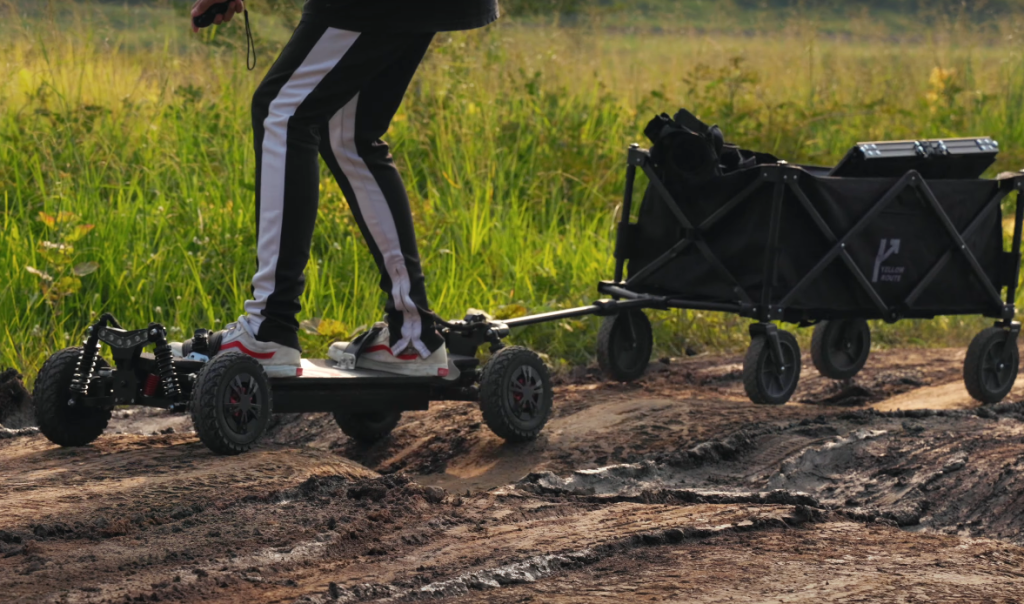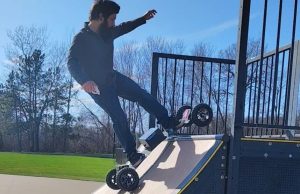Electric skateboards in 2025 have come a long way in accommodating heavier riders. For anyone over 200 lbs, performance isn’t just about top speed or sleek design—it’s about real-world ride quality, stability, and long-term durability. In this guide, we’ll break down what features truly matter for heavy riders, how to evaluate a board beyond weight capacity, and which premium models are built to meet the challenge.

Why Weight Capacity Isn’t the Full Story
Most boards list a maximum weight capacity, typically between 200 to 300 lbs. But staying within that number doesn’t guarantee performance. Heavier riders may still face reduced acceleration, motor strain, deck flex, and shorter battery life. That’s because weight affects every major component—from torque output to braking response and structural fatigue over time.
To choose a board that holds up under load, focus less on the label and more on how each part is engineered to perform with extra weight.
Key Features That Matter Most for Heavy Riders
Choosing an electric skateboard as a heavier rider involves more than checking the listed weight limit. Components must work together to maintain power, stability, and comfort under load. The following features are essential for long-term performance and rider safety.
Deck Material and Rigidity
Deck strength directly impacts ride quality and long-term durability, especially for riders over 200 lbs. While some boards may advertise a 250–300 lb weight rating, the material and design of the deck determine whether that board can truly handle stress without compromising control.
Bamboo decks are often favored for their flex and shock absorption. However, under heavy weight, that flex increases dramatically and can cause instability at high speeds or during tight turns. This can lead to speed wobbles or bottoming out—especially when hitting bumps or descending slopes.
For riders over 220 lbs, a rigid deck—preferably made from carbon fiber composites or 7 to 12-ply Canadian maple—is much more reliable. These materials provide a stiff platform that resists flex, enhances cornering precision, and keeps the board stable under dynamic load. Decks with reinforced structures or metal support inserts offer added peace of mind for long-distance or high-speed rides.
Motor Torque and Configuration
Motor power is a limiting factor for heavy riders. More weight requires higher torque to maintain performance—especially during starts, hill climbs, and rapid acceleration. Boards with low-power motors may move, but they’ll struggle with sluggish acceleration, overheating, or voltage sag under strain.
Torque depends not just on wattage, but also on motor type and drive system:
- In the realm of electric skateboards, Hub Motor Drives are widely used due to their compact design and quiet operation. These motors are embedded directly in the wheels, offering a clean and maintenance-friendly setup.
- An advanced evolution of this system is the Planetary Gear Drive—a high-torque upgrade built upon the hub motor concept. By integrating a compact gear reduction mechanism inside the motor housing, this design amplifies torque output significantly.
While standard hub motors suffice for light commuting and flat surfaces, planetary gear drives are better suited for riders requiring stronger acceleration and load-bearing capabilities. The internal gearing acts as a torque multiplier, enabling the board to handle steeper inclines, rougher surfaces, and heavier loads with greater stability.
For individuals above 250 lbs, configurations with dual planetary gear drives or high-powered multi-motor hub systems are generally the baseline.
Battery Output and Cell Quality
Battery performance plays a critical role in how long and how well a board handles weight. Heavier riders require more watt-hours per mile, which means batteries must deliver consistent power output without sagging or overheating.
Key battery specs to look for include:
- Voltage (12S or 14S systems): Higher-voltage setups (50.4V–58.8V) support more powerful motors and reduce current draw, minimizing heat and improving efficiency.
- Amp-Hour Rating (Ah): An 18Ah or larger pack is recommended for heavier riders, offering increased range and less stress on each cell.
- Battery Cells: Look for boards using 21700 high-discharge lithium cells, which outperform older 18650 cells in terms of output, longevity, and heat resistance.
Voltage sag is a common issue for heavier riders. It causes noticeable drop-offs in speed and torque as the battery depletes. Boards that use smart battery management systems (BMS) and high-drain cells will offer more consistent output, reducing mid-ride performance dips.
Suspension, Trucks, and Wheels
Heavy riders place more load on every bump, crack, and turn. Without proper suspension and wheel design, vibrations can lead to foot fatigue, poor handling, and long-term deck damage.
Boards designed for heavier users often include:
Independent suspension systems or spring-based suspension trucks, which isolate shocks from the deck and keep the wheels planted on uneven ground. These are especially important for off-road or all-terrain boards.
Shock-absorbing trucks (like double kingpin setups with bushings or dampers) improve turning response while reducing vibration.
Pneumatic tires (air-filled) or large-diameter airless rubber tires help cushion impacts and improve traction. Sizes between 150mm to 200mm (6–8 inches) are ideal for weight support and terrain versatility.
Standard urethane street wheels are not ideal for heavier riders on anything but smooth asphalt. Boards built for load handling should have off-road or hybrid wheels, reinforced axles, and trucks made from forged or CNC-machined aluminum for added durability
Braking Systems and Control Reliability
Braking performance is often overlooked but critical for heavier riders. More weight translates to more forward momentum—and that means longer stopping distances if the braking system isn’t designed to handle it.
Most premium boards use regenerative electronic braking, which feeds energy back into the battery. However, the controller must be calibrated to brake gradually and effectively under high momentum. Sudden or overly aggressive braking can destabilize the rider, especially at higher speeds.
Boards like the Ecomobl M24 and Telum X5 feature finely tuned firmware that offers smooth, responsive braking—even under the added inertia of heavier riders. This feature is especially useful when descending hills or riding in traffic.
Wireless remotes with adjustable braking curves are another valuable feature—allowing riders to customize brake intensity depending on terrain or body weight.

Top Electric Skateboards for Heavy Riders (2025)
Ecomobl specializes in high-performance, heavy-duty electric skateboards. Two standout models—the M24 (4WD) and Telum X5—combine raw power with structural integrity, built specifically for demanding riders and rough terrain.
Ecomobl M24 (4WD) – Heavy-Duty Powerhouse
- Rider Weight Limit:330 lbs
- Motors: 6382 Motor x 4
- Battery: 25Ah 12S5P
- Deck: 7 layer maple + 2 layer fiber glass
- Top Speed: 27-30 mph
- Drivetrain: Planetary Gear Drive
Designed for serious off-road riders, the M24 is built for high torque and all-terrain durability. Its four 6382 motors deliver up to 12,200W of combined power through a planetary gear drive, offering strong hill climbing and trail control. Rugged, responsive, and long-lasting—this board is engineered to carry heavy riders through the toughest environments.
Ecomobl Telum X5 – Balanced Urban and Trail Performance
- Rider Weight Limit:330 lbs
- Motors: 6385 Motor with Hall Sensor
- Battery: 10C 40T 14S6P 24Ah
- Deck: 100% Carbon Fiber Flexi Deck
- Top Speed: 30-35 mph
- Drivetrain: Planetary Gear Drive
The Telum X5 is a high-powered all-rounder. Equipped with four 6385 motors and Hall sensors, it responds quickly to throttle input and maintains speed even under load. Its carbon fiber flex deck adds comfort without compromising strength, and dual suspension trucks help manage bumps, cracks, and uneven pavement.
Side-by-Side Comparison
| Feature | Ecomobl M24 | Ecomobl Telum X5 |
| Weight Capacity | 330 lbs (150 kg) | 330 lbs (150 kg) |
| Motor Setup | 6382 Motors*4 (12,200W total) | 6385 Motor with Hall Sensor (15,000W total) |
| Battery | 25Ah 12S5P | 24Ah, 14S6P, 10C 40T |
| Deck Material | 7-layer maple + 2-layer fiberglass | 100% Carbon Fiber Flexi Deck |
| Terrain | Off-road, Mountain Trails | Urban, Light Off-road |
| Top Speed | Up to 30 mph (50 km/h) | Up to 35 mph (55 km/h) |
| Range | Up to 30 miles (50 km) | Up to 35 miles (60 km) |
| Best For | Off-road riders, trail explorers | Urban riders, versatile commuters |
Real-World Riding: What Heavy Riders Can Expect
Braking and Safety
The more weight, the more momentum. Regenerative braking on Ecomobl boards is designed to slow heavier riders down without losing control, even on downhill trips. Not only is this safer, but it also saves battery life.
Ride Stability
A rigid deck and quick-acting suspension cut down on flex and wobble. For heavy riders, this means fewer speed wobbles and better cornering, especially on rough terrain.
Uphill Performance
Torque is applied on hills. Both the Telum X5 and M24 deliver solid climbing power without throttle lag or overrunning heat, even when carrying more than 250 lbs.
FAQs: Electric Skateboards for Heavy Riders
Q1: What is the ideal weight capacity for an electric skateboard for heavier riders?
Look for boards that support 250 to 300 lbs minimum. But don’t look at just weight rating—structural stiffness, motor torque, and battery power are also crucial.
Q2: Am I allowed to ride an electric skateboard if I weigh more than the posted maximum?
Technically, yes, but don’t. It will cause overheating, flexing, reduced torque, and premature wear on major components. Always ride a board of your weight range to promote safety and performance.
Q3: What deck is best for heavy riders?
Heavy riders need to avoid elastic decks like bamboo. Multi-layer maple or carbon fiber decks are the choices, with greater stiffness and control available, especially for high speed, carving, or downhill riding.
Q4: Which motor type is better for heavy riders—standard hub motors or planetary gear drives?
Planetary gear drives are upgraded hub motors with internal gearing that boosts torque. They’re better suited for heavy riders, offering stronger acceleration and hill-climbing power than standard hub motors.
Q5: Is rider weight significant on range?
Yes. Heavier riders take more power out of the battery, which reduces range by 15–30%, depending on terrain and riding style. Boards with high-capacity batteries (18Ah+ with 12S or 14S configurations) provide a consistent range.
Q6: Are heavy riders able to ride electric skateboards off-road?
Yes, but set up correctly. You need:
- High-torque motors
- Pneumatic or airless all-terrain tires
- Heavy suspension and trucks
- Rigid deck with ground clearance
Final Thoughts
For heavy riders, the best electric skateboard isn’t just one that claims to support more weight—it’s one designed to perform under that weight consistently, safely, and comfortably. Ecomobl’s M24 and Telum X5 stand out by combining torque, deck rigidity, long-range batteries, and suspension systems that work in unison under pressure.
Whether you’re blazing through trails or navigating the city, these boards deliver power, control, and confidence for bigger riders who refuse to compromise.




